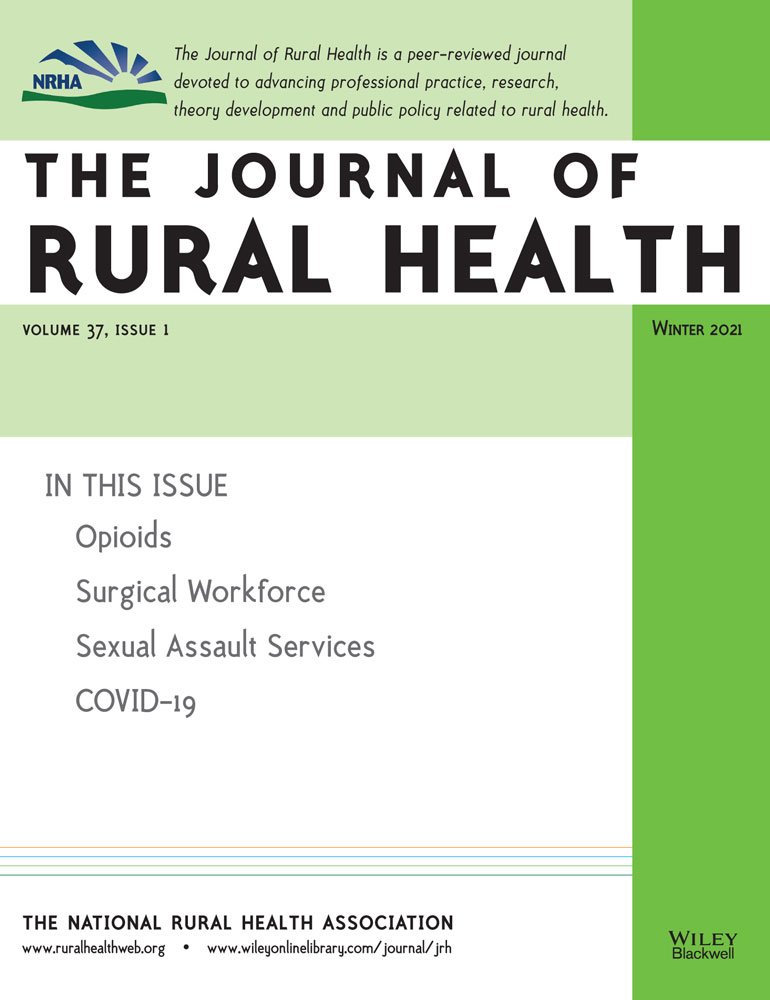Barriers to Telemedicine Implementation in Southwest Tribal Communities During COVID-19
Corresponding Author
Janessa M. Graves PhD, MPH
College of Nursing, Washington State University, Spokane, Washington
For further information, contact: Janessa M. Graves, PhD, MPH, College of Nursing, Washington State University, 412 E. Spokane Falls Blvd, Spokane, Washington 99201; e-mail: [email protected].
Search for more papers by this authorJessica L. Mackelprang PhD
School of Health Sciences, Swinburne University of Technology, Melbourne, Victoria, Australia
Search for more papers by this authorSolmaz Amiri DDes
Elson S. Floyd College of Medicine, Washington State University, Spokane, Washington
Search for more papers by this authorDemetrius A. Abshire PhD, RN
College of Nursing, University of South Carolina, Columbia, South Carolina
Search for more papers by this authorCorresponding Author
Janessa M. Graves PhD, MPH
College of Nursing, Washington State University, Spokane, Washington
For further information, contact: Janessa M. Graves, PhD, MPH, College of Nursing, Washington State University, 412 E. Spokane Falls Blvd, Spokane, Washington 99201; e-mail: [email protected].
Search for more papers by this authorJessica L. Mackelprang PhD
School of Health Sciences, Swinburne University of Technology, Melbourne, Victoria, Australia
Search for more papers by this authorSolmaz Amiri DDes
Elson S. Floyd College of Medicine, Washington State University, Spokane, Washington
Search for more papers by this authorDemetrius A. Abshire PhD, RN
College of Nursing, University of South Carolina, Columbia, South Carolina
Search for more papers by this authorFunding: Janessa Graves was supported in part by the Health Equity Research Center, a strategic research initiative of Washington State University. Dr Demetrius Abshire was supported by the National Institute on Minority Health and Health Disparities of the National Institutes of Health under Award Number K23MD013899. The content is solely the responsibility of the authors and does not necessarily represent the official views of the National Institutes of Health.
References
- 1Leavitt RA, Ertl A, Sheats K, Petrosky E, Ivey-Stephenson A, Fowler KA. Suicides among American Indian/Alaska Natives—National Violent Death Reporting System, 18 States, 2003-2014. MMWR Morb Mortal Wkly Rep. 2018; 67(8): 237-242.
- 2 National Academies of Sciences Engineering, and Medicine. Chapter 4. Addressing quality and access: promoting behavioral health in rural communities. In: Achieving Behavioral Health Equity for Children, Families, and Communities: Proceedings of a Workshop. Washington, DC: The National Academies Press; 2019: 27-36.
- 3Sidhu SS, Fore C, Shore JH, Tansey E. Chapter 11. Telemental health delivery for rural Native American populations in the United States. In: H Jefee-Bahloul, A Barkil-Oteo, EF Augusterfer, eds. Telemental Health in Resource-limited Global Settings. Oxford, UK: Oxford University Press; 2017: 161-180.
- 4Dorn Av, Cooney RE, Sabin ML. COVID-19 exacerbating inequalities in the US. The Lancet. 2020; 395(10232): 1243-1244.
- 5Kakol M, Upson D, Sood A. Susceptibility of Southwestern American Indian tribes to coronavirus disease 2019 (COVID-19) [published online ahead of print, 2020 Apr 18]. J Rural Health. 2020. https://doi.org/10.1111/jrh.12451.
- 6Wright JH, Caudill R. Remote treatment delivery in response to the COVID-19 pandemic. Psychother Psychosom. 2020; 89(3): 130-132.
- 7Golberstein E, Wen H, Miller BF. Coronavirus disease 2019 (COVID-19) and mental health for children and adolescents [published online ahead of print, 2020 Apr 14]. JAMA Pediatr. 2020. https://doi.org/10.1001/jamapediatrics.2020.1456.
- 8Rockwell KL, Gilroy AS. Incorporating telemedicine as part of COVID-19 outbreak response systems. Am J Manag Care. 2020; 26(4): 147-148.
- 9Chauhan V, Galwankar S, Arquilla B, et al. Novel coronavirus (COVID-19): leveraging telemedicine to optimize care while minimizing exposures and viral transmission. J Emerg Trauma Shock. 2020; 13(1): 20-24.
- 10Nagata JM. Rapid Scale-up of telehealth during the COVID-19 pandemic and implications for subspecialty care in rural areas [published online ahead of print, 2020 Apr 3]. J Rural Health. 2020. https://doi.org/10.1111/jrh.12433
- 11 U.S. Census Bureau. American Community Survey, 2018 American Community Survey 5-Year Estimates (2014-2018), Table S2801. Available at: https://data.census.gov/cedsci/table?q=2018%20broadband&hidePreview=true&tid=ACSST5Y2018.S2801&y=2018&vintage=2018/. Accessed May 21, 2020.
- 12Wang HL. Native Americans on Tribal Land Are “The Least Connected” to High-Speed Internet. National Public Radio. Available at: https://www.npr.org/2018/12/06/673364305/native-americans-on-tribal-land-are-the-least-connected-to-high-speed-internet. Accessed May 19, 2020.
- 13 Federal Communications Commission, Consumer & Governmental Affairs Bureau, Wireless Telecommunications Bureau, Wireline Competition Bureau. Report on Broadband Deployment in Indian Country, Pursuant to the Repack Airwaves Yielding Better Access for Users of Modern Services Act of 2018. Federal Communications Commission; 2019. Available at: https://www.fcc.gov/document/report-broadband-deployment-indian-country. Accessed May 18, 2020.
- 14Fraser S, Mackean T, Grant J, Hunter K, Towers K, Ivers R. Use of telehealth for health care of Indigenous peoples with chronic conditions: a systematic review. Rural Remote Health. 2017; 17(3): 4205. https://doi.org/10.22605/RRH4205




